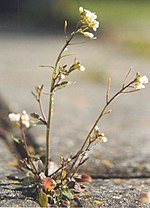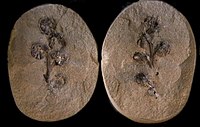Plant evolutionary developmental biology
Most of the synthesis in evo-devo has been in the field of
Historical perspective
Before 1900

The origin of the term "
In the middle centuries, several basic foundations of our current understanding of plant morphology were laid down. Nehemiah Grew, Marcello Malpighi, Robert Hooke, Antonie van Leeuwenhoek, Wilhelm von Nageli were just some of the people who helped build knowledge on plant morphology at various levels of organisation. It was the taxonomical classification of Carl Linnaeus in the eighteenth century though, that generated a firm base for the knowledge to stand on and expand.[8] The introduction of the concept of Darwinism in contemporary scientific discourse also had had an effect on the thinking on plant forms and their evolution.
1900 to the present

The past century witnessed a rapid progress in the study of
In 1959 Walter Zimmermann published a revised edition of Die Phylogenie der Planzen.[12] This very comprehensive work, which has not been translated into English, has no equal in the literature. It presents plant evolution as the evolution of plant development (hologeny). In this sense it is plant evolutionary developmental biology (plant evo-devo). According to Zimmermann, diversity in plant evolution occurs though various developmental processes. Three very basic processes are heterochrony (changes in the timing of developmental processes), heterotopy (changes in the relative positioning of processes), and heteromorphy (changes in form processes).[13]
In the meantime, by the beginning of the latter half of the 1900s, Arabidopsis thaliana had begun to be used in some developmental studies. The first collection of Arabidopsis thaliana mutants were made around 1945.[14] However it formally became established as a model organism only in 1998.[15]
The recent spurt in information on various plant-related processes has largely been a result of the revolution in
Gérard Cusset provided a detailed in-depth analysis of the history of plant morphology, including plant development and evolution, from its beginnings to the end of the 20th century.[18] Rolf Sattler discussed fundamental principles of plant morphology[19][20] and plant evo-devo.[21][22][23] Rolf Rutishauser surveyed the past and future of plant evo-devo with regard to continuum and process morphology.[24]
Organisms, databases and tools

The most important
Some people have objected against extending the results of
Since the past few years, researchers have indeed begun looking at non-model, "non-conventional" organisms using modern genetic tools. One example of this is the
Apart from
Evolution of plant morphology
Overview of plant evolution
Evidence suggests that an algal scum formed on the land 1,200 million years ago, but it was not until the Ordovician period, around 500 million years ago, that land plants appeared. These began to diversify in the late Silurian period, around 420 million years ago, and the fruits of their diversification are displayed in remarkable detail in an early
Meristems
The
Evolution of plant transcriptional regulation
Transcription factors and transcriptional regulatory networks play key roles in plant development and stress responses, as well as their evolution. During plant landing, many novel transcription factor families emerged and are preferentially wired into the networks of multicellular development, reproduction, and organ development, contributing to more complex morphogenesis of land plants.[38]
Evolution of leaves
Origins of the leaf

Contrary to the telome theory, developmental studies of compound leaves have shown that, unlike simple leaves, compound leaves branch in three dimensions.[41][42] Consequently, they appear partially homologous with shoots as postulated by Agnes Arber in her partial-shoot theory of the leaf.[43] They appear to be part of a continuum between morphological categories, especially those of leaf and shoot.[44][45] Molecular genetics confirmed these conclusions (see below).
It has been proposed that the before the evolution of
Factors influencing leaf architectures
Various physical and physiological forces like
Genetic evidences for leaf evolution
At the genetic level, developmental studies have shown that repression of the KNOX genes is required for initiation of the

One feature of a plant is its
Once the leaf primordial cells are established from the SAM cells, the new
How the infinite variety of plant leaves is generated is a subject of intense research. Some common themes have emerged. One of the most significant is the involvement of KNOX genes in generating
Molecular genetics has also shed light on the relation between radial symmetry (characteristic of stems) and dorsiventral symmetry (typical for leaves). James (2009) stated that "it is now widely accepted that... radiality [characteristic of most shoots] and dorsiventrality [characteristic of leaves] are but extremes of a continuous spectrum. In fact, it is simply the timing of the KNOX gene expression!"[54] In fact there is evidence for this continuum already at the beginning of land plant evolution.[55] Furthermore, studies in molecular genetics confirmed that compound leaves are intermediate between simple leaves and shoots, that is, they are partially homologous with simple leaves and shoots, since "it is now generally accepted that compound leaves express both leaf and shoot properties”.[56] This conclusion was reached by several authors on purely morphological grounds.[41][42]
Evolution of flowers

Flower-like structures first appear in the fossil records some ~130 mya, in the Cretaceous era.[57]
The flowering plants have long been assumed to have evolved from within the
| Traditional view | |||||||||||||||||||||||||||||||||
|---|---|---|---|---|---|---|---|---|---|---|---|---|---|---|---|---|---|---|---|---|---|---|---|---|---|---|---|---|---|---|---|---|---|
|
| Modern view | ||||||||||||||||||||||||||||||||||||
|---|---|---|---|---|---|---|---|---|---|---|---|---|---|---|---|---|---|---|---|---|---|---|---|---|---|---|---|---|---|---|---|---|---|---|---|---|
|
The main function of a flower is
Origins of the flower
It seems that on the level of the organ, the
Evolution of the MADS-box family
The members of the
The evolution of the
Factors influencing floral diversity

How is the enormous diversity in the shape, color and sizes of flowers established? There is enormous variation in the developmental program in different plants. For example,
Arabidopsis thaliana has a gene called
Some of these changes also cause changes in expression patterns of the developmental genes, resulting in different
Flowering time
Another floral feature that has been a subject of
Many genes in the flowering time pathway are conserved across all plants studied to date. However, this does not mean that the mechanism of action is similarly conserved. For example, the monocot rice accelerates its flowering in short-day conditions, while Arabidopsis thaliana, a eudicot, responds to long-day conditions. In both plants, the proteins CO and FT are present but in Arabidopsis thaliana CO enhances FT production, while in rice the CO homolog represses FT production, resulting in completely opposite downstream effects.[70]
Theories of flower evolution
There are many theories that propose how flowers evolved. Some of them are described below.
The
The Mostly Male Theory has a more genetic basis. Proponents of this theory point out that the gymnosperms have two very similar copies of the gene LFY while angiosperms only have one.
Evolution of secondary metabolism
Plant
Mechanisms and players in evolution
While environmental factors are significantly responsible for evolutionary change, they act merely as agents for
In recent times, plants have been shown to possess significant microRNA families, which are conserved across many plant lineages. In comparison to animals, while the number of plant miRNA families is less, the size of each family is much larger. The miRNA genes are also much more spread out in the genome than those in animals, where they are found clustered. It has been proposed that these miRNA families have expanded by duplications of chromosomal regions.[74] Many miRNA genes involved in regulation of plant development have been found to be quite conserved between plants studied.

Crosses between a particular teosinte variety and maize yield fertile offspring that are intermediate in
Another case is that of cauliflower. The edible cauliflower is a domesticated version of the wild plant Brassica oleracea, which does not possess the dense undifferentiated inflorescence, called the curd, that cauliflower possesses.
Cauliflower possesses a single mutation in a gene called CAL, controlling meristem differentiation into inflorescence. This causes the cells at the floral meristem to gain an undifferentiated identity, and instead of growing into a flower, they grow into a lump of undifferentiated cells.[76] This mutation has been selected through domestication at least since the Greek empire.
See also
- Plant morphology
- Comparative phylogenetics
- Plant evolution
- Evolutionary history of plants
References
- S2CID 40347284.
- PMID 10781035.
- S2CID 81013686.
- ^ Minelli, A. 2018. Plant Evolutionary Biology. The Evolvablity of the Phenotype. New York: Cambridge University Press.
- ^ PMID 21669604.
- ^ Cusset G (1982). "The Conceptual Bases of Plant Morphology." In: Sattler R (1982). Axioms and Principles of Plant Construction. The Hague: Martinus Nijoff/ Dr W. Junk Publishers, p.27 (also published in Acta Biotheretica 31A)
- ^ Sattler, R. (2018). "Philosophy of Plant Morphology". Elemente der Naturwissenschaft. 108: 55–79.(for an expanded version of this article see [1])
- ^ http://www.cas.muohio.edu/~meicenrd/ANATOMY/Ch0_History/history.html Plant Morphology: Timeline
- PMID 16586955.
- ^ Jeffrey CE (1910). Collected papers. pp. 317–.
- ^ Plant Science Bulletin
- ^ Zimmermann, W. 1959. Die Phylogenie der Pflanzen. Revised 2nd edition. Stuttgart: Gustav Fischer Verlag.
- PMID 36616247.
- ^ [2] TAIR: About Arabidopsis
- ^ PMID 9611166.
- ^ The Arabidopsis Information Resource
- ^ NCBI dbEST Statistics
- ^ Cusset G (1982). "The Conceptual Bases of Plant Morphology." In: Sattler R (1982). Axioms and Principles of Plant Construction. The Hague: Martinus Nijoff/ Dr W. Junk Publishers, pp. 8–86 (also published in Acta Biotheretica 31A)
- ^ Sattler, R. "Plant Morphology. Fundamental Issues".[3]
- ^ Sattler, R. (2018). "Philosophy of Plant Morphology". Elemente der Naturwissenschaft. 108: 55–79.(for an expanded version of this article see [4])
- PMID 36616247.
- PMC 10935004.
- ^ Sattler, R. "Plant evo-devo and the morphological research by Rolf Sattler and collaboraters". [5]
- PMID 5040041.
- ^ NCBI Plant Genomes Central
- PMID 10588717.
- ^ S2CID 22929939.
- ^ The Floral Genome Project Home
- ^ PlantGDB
- ^ Cycad Genomics Project home Archived 2007-10-17 at the Wayback Machine
- PMID 16626449.
- PMID 28347942.
- PMID 21427719.
- S2CID 1417664.
- S2CID 4404460.
- PMID 25631928.
- .
- PMID 25750178.
- S2CID 23626358.
- PMID 16101907.
- ^ a b Rutishauser, R. and Sattler, R. 1997. Expression of shoot processes in leaf development of Polemonium caeruleum. Botanische Jahrbücher für Systematik 119: 563-582.
- ^ .
- .
- JSTOR 42758718.
- .
- S2CID 4386118.
- ^ A perspective on the CO2 theory of early leaf evolution Archived 2011-06-29 at the Wayback Machine
- .
- S2CID 4335275.
- PMID 9847245.
- PMID 15749758.
- PMID 11743098.
- S2CID 8059321.
- ^ James, P. J. 2009. 'Tree and Leaf': A different angle. The Linnean 25, p. 17.
- ^ Sattler, R. 1998. On the origin of symmetry, branching and phyllotaxis in land plants. In: R.V. Jean and D. Barabé (eds) Symmetry in Plants. World Scientific, Singapore, pp. 775-793.
- PMID 20647343.
- ^ PMID 10717683.
- ^ PMID 10760277.
- ^ PMID 21665594.
- ^ PMID 10760278.
- PMID 12777513.
- ^ PMID 11087846.
- S2CID 7399106.
- PMID 12679535.
- S2CID 58620687.
- PMID 10808068.
- PMID 9490741.
- PMID 17658290.
- S2CID 43335309. Archived from the originalon 2012-12-16.
- PMID 11743019.
- S2CID 85612923.
- PMID 11044721.
- PMID 9539701.
- PMID 17130846.
- PMID 15568971.
- PMID 10835404.
